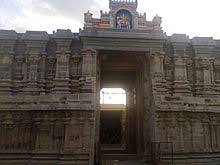Sri Vaikuntam Sri Vaikundanathar Tirukkovil, Thoothukudi

Address
Sri Vaikundanathar Tirukkovil, Sri Vaikuntam – 628 601, Thoothukudi District Phone: +91 4630 256 476 Mobile: 98656 28681 / 99521 62359
Deity
Vaikundanathar, Amman: Vaikundavalli.
Introduction
- Sri Vaikuntanathan Perumal Temple (also called Srivaikundam temple/Kallapiran temple) is located in Srivaikundam, Thoothukudi district, Tamil Nadu.
- Dedicated to Lord Vishnu (Vaikuntanathar) and his consort Lakshmi (Vaikundavalli).
- 22 km from Tirunelveli, built in Dravidian style, glorified in Divya Prabandha.
- One of the 108 Divya Desams and classified as a Navathiruppathi temple.
- Associated with the Sun God (Surya) and one of the Navagraha temples in Vaishnavism.
- Unique feature: Sun’s rays fall directly on the deity twice a year (April-May & October-November).
- Used as a fort during the fight between Veerapandiya Kattabomman and the British.
Puranic Significance
- Legend of Somukasura: Demon stole the four Vedas; Vishnu, as Matsya avatar, retrieved them and stayed as Vaikuntanathar.
- Cow Miracle Legend: A cow performed ablution at the deity’s hidden spot, leading to the temple’s rediscovery.
- Kaladushana & the Pandya King: Lord Vishnu appeared as a robber (Kallapiran) to teach a moral lesson about wealth accumulation.
Beliefs
- Worship at the temple for overcoming marriage obstacles, childbirth, and good education.
- Devotees perform Thirumanjanam (sacred bath) and offer new clothes to the deity.
Special Features
- Temple Complex: Covers 5 acres, with a 110 ft rajagopuram and a granite wall enclosing its shrines and tanks.
- Sanctum: Houses Srivaikuntanathar in standing posture, with Adisesha holding a parasol over his head.
- Ardha Mandapa: Features a festival idol of Vishnu with Sridevi & Bhudevi; sculptor is said to have caressed the deity’s cheeks.
- Unique Adisesha depiction: Unlike other temples, Adisesha guards Vishnu in a standing posture.
- Other Shrines: Includes Vishvaksena, Garuda, Venugopala Krishna, Manavala Mamunigal, and Yoga Narasimha.
- Temple precincts: Five sections, with Mahamandapa & Swarga Mandapa as later additions.
Festivals
- Garuda Sevai Utsavam (Vaikasi – May/June) features nine Garuda processions.
Century/Period/Age
1000 to 2000 years old
Managed By
Hindu Religious and Charitable Endowments (HRCE)
Nearest Bus Station
Tirunelveli
Nearest Railway Station
Tirunelveli
Nearest Airport
Trivandrum









